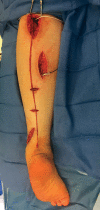Management of Sural Nerve Neuromas with Targeted Muscle Reinnervation
- PMID: 32095388
- PMCID: PMC7015593
- DOI: 10.1097/GOX.0000000000002545
Management of Sural Nerve Neuromas with Targeted Muscle Reinnervation
Abstract
Neuromas are a debilitating peripheral nerve problem due to aberrant axon sprouting and inflammation after nerve injury. The surgical management of neuromas has for a long time been up for debate, largely due to lack of consistent, reliable outcomes with any one technique. We have found success utilizing targeted muscle reinnervation, a technique originally described in amputees that re-routes the proximal ends of cut sensory nerve stumps into the distal ends of motor nerves to nearby muscles. In doing so, the sensory nerve ending can regenerate along the length of the motor nerve, giving it a place to go and something to do. In this report, we describe our technique specifically for targeted muscle reinnervation of sural nerve neuromas that is applicable to both amputees and to patients with intact limbs. Sural nerve neuromas can occur after sural nerve harvest for reconstructive procedures and particularly after lateral malleolar incisions for orthopedic access to the calcaneus. By re-routing the sural nerve into a motor nerve of the lateral gastrocnemius muscle, we are able to manage a variety of sural nerve neuromas presenting anywhere along the course of the sural nerve and in a variety of clinical settings.
Copyright © 2020 The Authors. Published by Wolters Kluwer Health, Inc. on behalf of The American Society of Plastic Surgeons.
Conflict of interest statement
Figures


References
-
- Pierce RO, Jr, Kernek CB, Ambrose TA., II. The plight of the traumatic amputee. Orthopedics. 1993;16:793–797. - PubMed
-
- Rajput K, Reddy S, Shankar H. Painful neuromas. Clin J Pain. 2012;28:639–645. - PubMed
-
- Thomson CE, Beggs I, Martin DJ, et al. Methylprednisolone injections for the treatment of morton neuroma: a patient-blinded randomized trial. J Bone Joint Surg Am. 2013;95:790–798. - PubMed
LinkOut - more resources
Full Text Sources
